Network Topology:
Network Topology is the schematic description of a network arrangement, connecting various nodes (sender and receiver) through lines of connection. Now let's discuss some network topologies:
BUS Topology
Bus topology is a type of network topology in which all devices (computers, servers, printers, etc.) are connected to a central communication medium, known as a bus or backbone. In a bus topology, a single cable runs through the entire network, and all devices share this common communication channel.
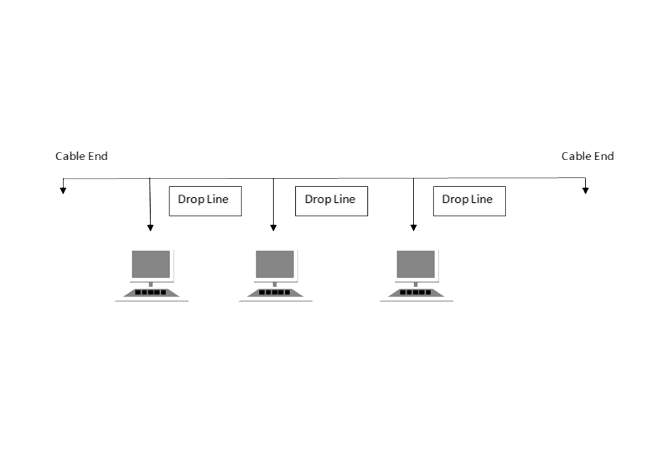
Features of Bus Topology:
- In a bus topology, there is a single communication channel (the bus), and all devices are connected to it.
- The ends of the bus must be properly terminated with terminators to prevent signal reflection and ensure the integrity of the transmitted data.
- Bus topology is relatively easy to install and requires less cabling compared to some other topologies.
| Advantages | Disadvantages |
|---|---|
| 1. It is cost effective. | 1. Cables fails then whole network fails. |
| 2. Cable required is least compared to other network topology. | 2. Cable has a limited length. |
| 3. Easy to expand joining two cables together. | 3. If network traffic is heavy or nodes are more the performance of the network decreases. |
| 4. It is easy to understand. | 4. It is slower than the ring topology. |
Despite its simplicity, bus topology is less commonly used in modern networks, especially in larger or more complex setups. More advanced topologies like star or ring are often preferred because they offer better scalability, easier fault isolation, and higher reliability.
• Bus topology is still found in some basic applications or educational environments.
RING Topology
Ring topology is a type of network topology in which each network device is connected to exactly two other devices, forming a single continuous pathway for signals through each device—a "ring." Data travels in one direction around the ring until it reaches its destination or encounters a repeater, which regenerates the signal and allows it to continue around the ring.

Features of Ring Topology:
- A number of repeaters are used for Ring topology with large number of nodes, because if someone wants to send some data to the last node in the ring topology with 100 nodes, then the data will have to pass through 99 nodes to reach the 100th node. Hence to prevent data loss repeaters are used in the network.
- The transmission is unidirectional, but it can be made bidirectional by having 2 connections between each Network Node, it is called Dual Ring Topology.
- In Dual Ring Topology, two ring networks are formed, and data flow is in opposite direction in them. Also, if one ring fails, the second ring can act as a backup, to keep the network up.
| Advantages | Disadvantages |
|---|---|
| 1. Transmitting network is not affected by high traffic or by adding more nodes. | 1. Troubleshooting is difficult in ring topology. |
| 2. Cheap to install and expand. | 2. Adding or deleting the computers disturbs the network activity. |
| 3. Data is transferred in a sequential manner. | 3. Failure of one computer disturbs the whole network. |
Ring topology is still used in certain applications, such as some local area networks (LANs) or in industrial settings where the closed-loop structure provides specific advantages. However, it has been largely supplanted by other topologies in many modern networking environments.
STAR Topology
Star topology is a type of network topology in which all network devices are connected to a central hub or switch. In a star topology, each device on the network communicates directly with the central hub, and the hub manages and controls the flow of data between the devices.
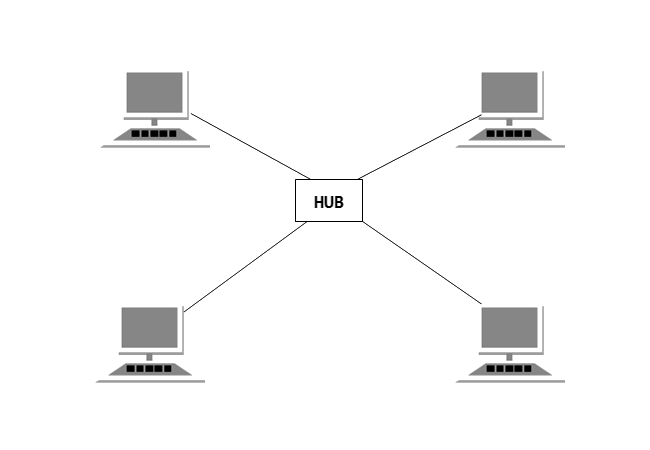
Features of Star Topology:
- The central hub or switch is the focal point of the star topology. All devices are connected to this central point.
- It is a scalable topology, allowing for the addition of more devices without affecting the overall network performance.
- The performance of the network depends on the capacity of the central hub. If the hub has a high data transfer rate, the overall network performance is likely to be good.
| Advantages | Disadvantages |
|---|---|
| 1. Fast performance with few nodes and low network traffic. | 1. Performance is based on the hub that is it depends on its capacity. |
| 2. Hub can be upgraded easily, and easy to troubleshoot. | 2. Cost of installation is high, and expensive to use. |
| 3. Only that node is affected which has failed, rest of the nodes can work smoothly. | 3. If the hub fails then the whole network is stopped because all the nodes depend on the hub. |
Star topology is commonly used in modern Ethernet networks, and it is a popular choice for local area networks (LANs). It provides a good balance between performance, scalability, and ease of management, making it suitable for a wide range of applications from home networks to large corporate environments.
MESH Topology
Mesh topology is a type of network topology where each device in the network is interconnected with every other device, forming a fully connected network. In a mesh topology, the connections can be either full mesh or partial mesh. It is a point-to-point connection to other nodes or devices. All the network nodes are connected to each other. Mesh has n(n-1)/2 physical channels to link n devices.
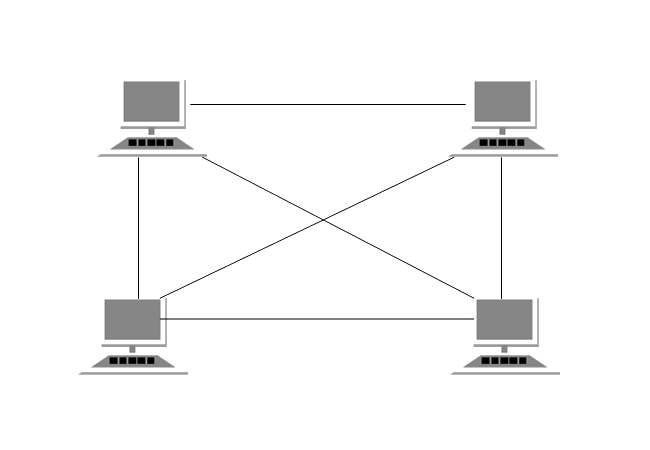
Features of Mesh Topology:
- Mesh topology offers high redundancy, meaning that if one link or node fails, alternative paths are available for data transmission.
- Mesh networks are scalable, and additional devices can be easily added without affecting the overall network structure.
- The performance of a mesh network can be high because multiple paths allow for efficient load distribution and reduced congestion.
| Advantages | Disadvantages |
|---|---|
| 1. Each connection can carry its own data load. | 1. Installation and configuration is difficult. |
| 2. It is robust, and fault is diagnosed easily. | 2. Cabling cost is more. |
| 3. Provides security and privacy. | 3. Bulk wiring is required. |
Mesh topologies are employed in scenarios where high reliability, fault tolerance, and redundant paths are crucial, such as in critical infrastructure, telecommunications, and some large-scale data center environments. While the cost and complexity associated with full mesh topologies can be limiting factors, the benefits of increased reliability often outweigh these considerations in specific use cases.
Q. What is Meshed Star Topology?
This is a variation of the star topology where each device is connected to multiple central hubs or switches, providing redundancy and fault tolerance similar to mesh topologies while maintaining the simplicity of star topologies.
TREE Topology
Tree topology, also known as hierarchical topology, is a type of network topology that combines characteristics of both star and bus topologies. In a tree topology, the network is structured hierarchically with multiple levels of hierarchy, and devices are connected in a way that resembles a tree structure.
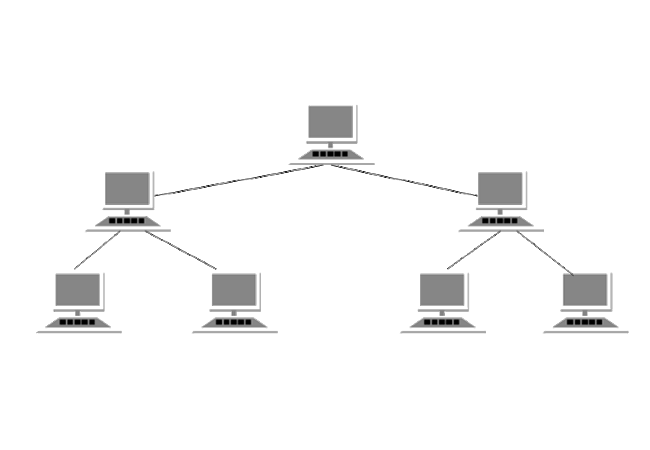
Features of Tree Topology:
- Tree topology is organized in a hierarchical structure with multiple levels. It often resembles an inverted tree, with the root node at the top and branches extending downward.
- Tree topology provides a level of reliability. If one branch fails, the rest of the network remains functional.
- Data flows from the top (root node) to the bottom (end devices) in a hierarchical manner.
| Advantages | Disadvantages |
|---|---|
| 1. Extension of bus and star topologies. | 1. Heavily cabled. |
| 2. Expansion of nodes is possible and easy. | 2. Cost is more. |
| 3. Easily managed and maintained. | 3. Central hub fails, network fails. |
| 4. Error detection is easily done. | 4. If more nodes are added maintenance is difficult. |
Tree topology provides a good balance between the simplicity of star topology and the scalability of bus or mesh topologies. It is particularly suitable for organizations with a distributed structure, where network resources need to be efficiently organized into different levels of hierarchy.
HYBRID Topology
Hybrid topology is a combination of two or more different types of network topologies. By integrating various topologies, a hybrid topology seeks to leverage the strengths of each topology while minimizing their weaknesses. This allows for the creation of complex and flexible network designs that can meet specific requirements.
Common examples of hybrid topologies include the combination of star and bus, star and ring, or any other combination that suits the needs of a particular network. The choice of hybrid topology depends on factors such as the size of the network, the type of devices connected, the desired level of redundancy, and the overall network goals.
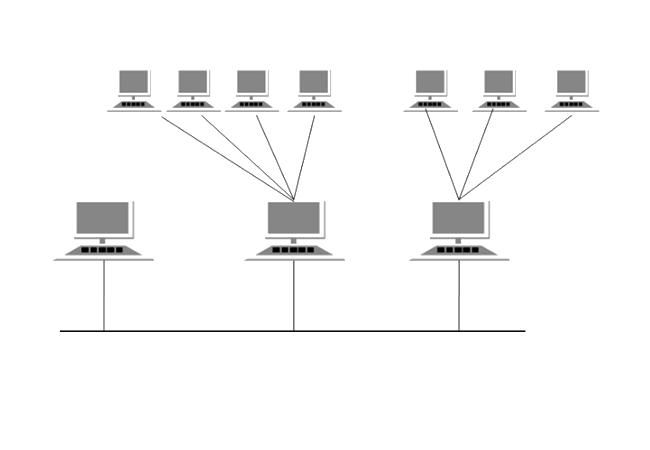
Features of Hybrid Topology:
- Hybrid topologies offer flexibility, allowing network designers to tailor the network to specific needs and requirements.
- The hybrid approach can provide scalability, making it suitable for networks that may need to grow or adapt over time.
- Hybrid topologies can enhance reliability by incorporating redundancy from multiple topologies. If one part of the network fails, other segments may still function.
| Advantages | Disadvantages |
|---|---|
| 1. Hybrid topologies can be easily scaled. | 1. The design and implementation of a hybrid topology can be complex. |
| 2. The combination of different topologies allows for the optimization of network performance. | 2. In some hybrid topologies, the overall network performance may depend on central components, such as central hubs or switches. |
| 3. By combining different topologies, hybrid networks can provide redundancy. | 3. Ongoing maintenance and troubleshooting can be more challenging. |
| 4. Hybrid topologies can be cost-efficient, as they allow for a balance between cost and performance. | 4. The initial setup costs might be higher due to the need for different types of hardware and cabling. |
Hybrid topologies are commonly employed in large and diverse networks where different sections of the network have varying requirements. The goal is to optimize the overall network performance by combining the advantages of different topologies in a way that suits the specific needs of the organization.
Category: Networking
on: 05 Jan 2021
on: 11 Sep 2022
Featured posts
You may like these posts.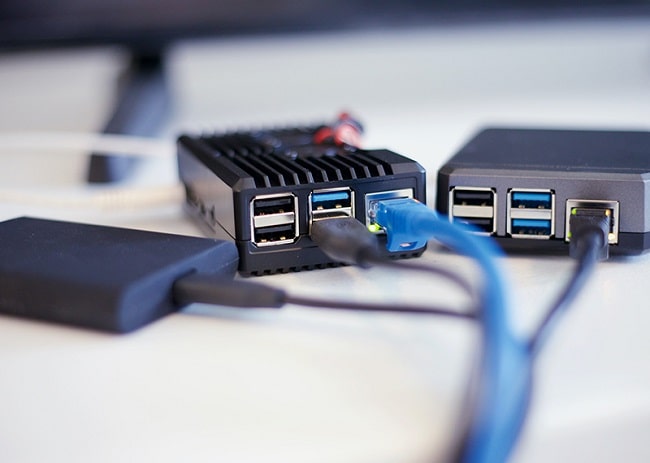
Transmission Modes - Simplex, Half-duplex, Full-duplex:
Transmission mode refers to the mechanism of transferring data between two devices connected over a network basically this process called Communication Mode.

Types of Firewall - Packet, Application, Proxy, NGFW:
Firewalls are often categorized as either network firewalls or host-based firewall. Firewalls may also be a component of your computer's operating system.

CrossFire, CrossfireX & SLI - AMD, ATI & NVDIA:
CrossFire is a high-performance PC gaming graphics platform made possible by the use of multiple graphics cards coupled with a CrossFire enabled motherboard.
What's Next?
We've now entered the finance section on this platform, where you can enhance your financial literacy.